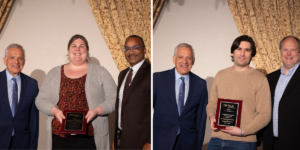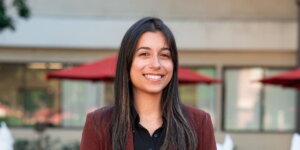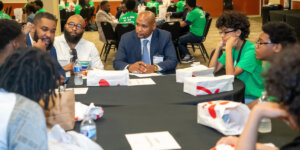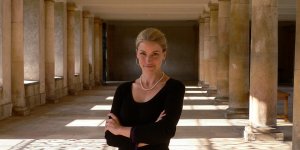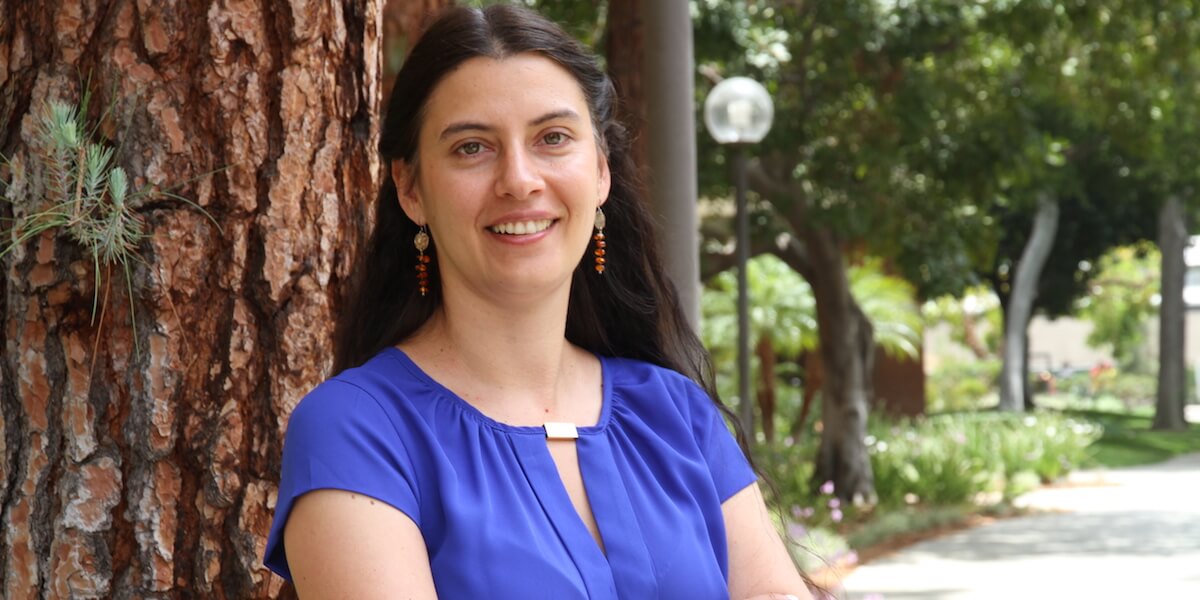
USC computer scientist and CAIS co-director Bistra Dilkina (Photo/Caitlin Dawson)
Bistra Dilkina, a leader in the burgeoning field of computational sustainability and whose research aims to leverage AI to find solutions to real-world problems, has become co-director of the USC Center for Artificial Intelligence in Society, or CAIS.
“I’m thrilled to be stepping up in my initiative to growing CAIS,” said Dilkina, an associate professor of computer science who joined the USC Viterbi School of Engineering from the Georgia Institute of Technology in spring 2018. “I think it’s an amazing organization that is doing and will continue to do wonderful things.”
Dilkina joins CAIS cofounder Eric Rice, an associate professor at the USC Suzanne Dworak-Peck School of Social Work, as center co-director.
“I am thrilled that Bistra will be stepping up to co-lead CAIS with me,” Rice said. “She is a brilliant scholar and a wonderful collaborator who has vision for how AI can positively impact societal problems.”
Dilkina also “represents a growing group of talented CS faculty who focus their research and teaching on the convergence of AI with society,” said Yannis Yortsos, USC Viterbi dean.
Launched in September 2016 as one of the first centers on AI for social good and the only academic center that is equal parts computer science and social work, CAIS seeks to bring AI and social work together for “a more just, healthy and sustainable world,” according to the group’s website. A joint venture between USC Viterbi and the School of Social Work, the center focuses on low-resource communities in the United States and globally. Current projects focus on seven core areas: homelessness; suicide prevention; substance abuse treatment and prevention; conservation and sustainability; health and well-being; disaster planning; and fairness, equity and bias.
CAIS works closely with several community partners, such as Safe Place for Youth and the Los Angeles LGBT Center, which provide services to local homeless youth; the Los Angeles Mayor’s Office; Los Angeles Department of Water and Power; and Panthera, a wildcat conservation group. The center also has research collaborations with faculty members at the University of Maryland and Harvard, Carnegie Mellon and Penn State universities, among many others.
In her new position, Dilkina wants to expand CAIS’s influence. “We’re going to increase our focus on vulnerable communities but within that focus broaden our footprint in the types of problems we address,” she said.
Dilkina also hopes to reach out to more college and even K-12 students to pique their interest in employing AI to address what she calls “wicked problems.” Toward that end, she teaches a USC Viterbi undergraduate class on AI for social good. Additionally, Dilkina aims to strengthen the center’s relationship with CAIS ++, a USC student-run and student-created group affiliated with CAIS for which Dilkina serves as faculty mentor.
“I really strongly believe that this idea of leveraging AI and social work to address social problems has to be nurtured early on,” she said. “I also believe that’s a way to grow our diversity, especially in our engineering population. Realizing that you can work on homelessness or substance abuse or conservation as a computer scientist or an engineer can attract people who wouldn’t otherwise think of studying those fields.”
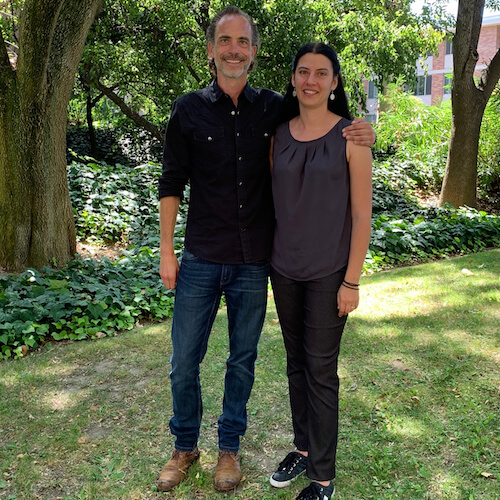
CAIS co-directors Eric Rice and Bistra Dilkina (Photo/Courtesy of CAIS)
Over the years, CAIS researchers have tackled several important projects.
Phebe Vayanos, a center associate director and USC Viterbi assistant professor of industrial and systems engineering and computer science, and her team have worked to develop an algorithm to reduce suicides among young people. The algorithm would identify the best person to train in a given group of young adults to serve as a gatekeeper capable of identifying warning signs of suicide and intervening to connect to appropriate resources. In addition, CAIS co-director Rice and others, supported by a $600,000 grant from the Army Research Office, are studying ways to employ AI to increase early interventions for military personnel at risk of suicide.
Tackling another pressing societal challenge, CAIS associate co-director Jordan Davis, an assistant professor in the School of Social Work, leads research addressing substance use and the developmental needs of marginalized and vulnerable populations. He collaborates with AI faculty to integrate this powerful technology into the models and analysis.
“CAIS has always been committed to doing research that has a real impact in vulnerable communities,” Rice said. “We think that by bringing together computer science, social work and community partners we can create new solutions to some of the most vexing problems facing humanity.”
Dilkina’s CAIS-related research has also proven quite innovative.
She belonged to a team that found that 13 million people could be forced to relocate by 2100 because of rising sea levels, moving to places like Atlanta, Denver and Midwest suburban and rural areas. To predict the trajectory migration caused by rising sea levels, Dilkina and other researchers took existing projections of rising sea levels and combined this with population projections. Based on migration patterns after Hurricane Katrina and Hurricane Rita, the team trained machine learning models—a subset of artificial intelligence—to predict where people would relocate.
More recently, Dilkina has worked with the Los Angeles Department of Water and Power. The project employs AI to suggest upgrades to city water pipes where the probability of earthquake damage is the highest and the customers serviced, such as firefighters and hospitals, would most need access to water after a major temblor.
“Let’s say I had enough funding to upgrade say 200 pipes out of the 5,000 pipes in the LA area,” she said. “That’s an astronomical number of combinations to consider, so AI helps to sift through those possibilities faster and find the best ones [for the entire network].”
A passionate wildlife conservationist, Dilkina has worked on a years-long, National Science Foundation-funded project with collaborators around the world to thwart illicit animal trafficking. The goal: create data-rich models identifying major illegal trafficking routes, including intermediate transfer points, to increase the likelihood for effective intervention.
Dilkina said she made the right choice in heading west to join USC Viterbi and CAIS.
“I am very inspired by the center’s vision and that there are so many faculty from engineering and social work dedicated to joining forces and closely collaborating to solve wicked problems,” she said. “I have found my research soulmates.”
Published on September 30th, 2020
Last updated on April 23rd, 2025





